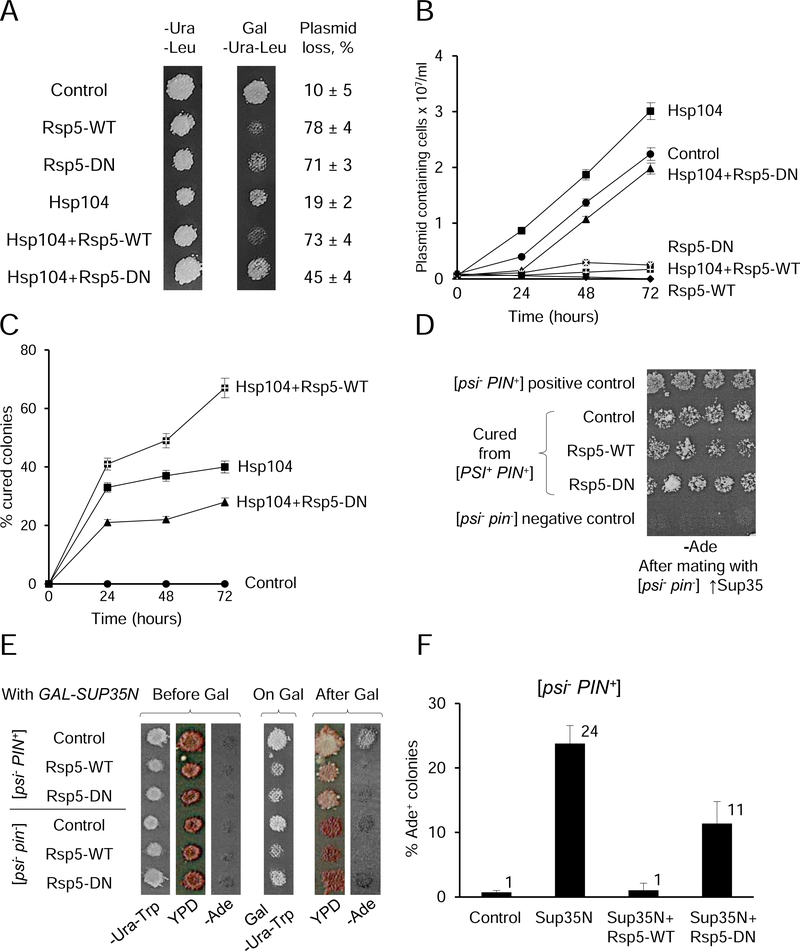Figure 6. Effects of Rsp5 overproduction or inactivation on yeast growth and prions.
(A) and (B) Inhibition of growth of the yeast strain OT56, bearing the [PIN+] and strong [PSI+] prions, by overproduction (Rsp5-WT) or inactivation (Rsp5-DN) of Rsp5, and impact of excess Hsp104 on growth inhibition. Each culture contained either a combination of two empty vectors (control), or indicated construct with an empty vector, or a combination of two constructs, as shown. Cultures bearing respective constructs under the galactose-inducible promoter were grown either on solid (A), or in the liquid (B) galactose (Gal) medium selective for plasmids, -Ura-Leu; glucose medium (A) is shown as a control. % of cells loosing any or both plasmids, with standard deviations (SDs), as shown on panel A was determined by streaking out for single colonies from Gal medium onto YPD and checking growth on -Ura-Leu. For numbers, see Table S2. For liquid medium (B), aliquots taken at various time points as indicated were diluted as appropriate and plated onto solid -Ura-Leu. Average concentrations of colony-forming plasmid-containing cells in each culture are shown, with error bars depicting SDs. For numbers, see Table S3. Designations are as follows:  Control,
Control,  Rsp5-WT,
Rsp5-WT,  Rsp5-DN,
Rsp5-DN,  Hspl04,
Hspl04,  Hspl04+Rsp5-WT,
Hspl04+Rsp5-WT,  Hspl04+Rsp5-DN. (C) [PSI+] loss in the strain OT56, containing the [PIN+] and strong [PSI+] prions following overproduction of Hsp104 (individually or in combination with Rsp5-WT or Rsp5-DN, as indicated) in the liquid Gal-Ura-Leu medium. Aliquots were taken at specified periods of time, diluted appropriately, and plated onto solid -Ura-Leu, followed by velveteen replica plating onto the YPD and -Ade media for the detection of [PSI+] prion. Average percentages of colonies that have lost [PSI+] prion are shown. Error bars depict SDs. For numbers, see Table S5. Designations are the same as on panel B. Data for the loss of strong and weak [PSI+] variants on solid medium are shown on Figure S5, D and E, and in Table S4. (D) The [PIN+] prion is not lost in the cells of the strain OT56, cured of [PSI+] by excess Hsp104, independently on the presence of Rsp5-WT or Rsp5-DN. Respective [psi−] colonies were mated to the [psi−
pin−] strain GT197, bearing the multicopy plasmid with SUP35 gene. Growth of diploids on the -Ade medium indicates the presence of [PIN+], required for induction of [PSI+] by multicopy SUP35. (E) and (F) Overproduction or inactivation of Rsp5 antagonizes de novo induction of [PSI+] prion by overexpression of PGAL-SUP35N in the [psi−
PIN+] strain, as detected by more reddish color on YPD and less growth on -Ade medium in the plate assay for the strain OT60 (E), and by lesser percentage of Ade+ among colonies grown on -Ura-Trp medium after streaking out from galactose medium for the strain GT159 (F), compared to the culture that overproduced Sup35N alone. Media designated as -Ura-Trp and Gal-Ura-Trp show growth of plasmid-containing cells, while the isogenic [psi−
pin−] strain is shown as a negative control for [PSI+] induction on panel E. Error bars on panel F indicate SDs. For numbers, see Table S6.
Hspl04+Rsp5-DN. (C) [PSI+] loss in the strain OT56, containing the [PIN+] and strong [PSI+] prions following overproduction of Hsp104 (individually or in combination with Rsp5-WT or Rsp5-DN, as indicated) in the liquid Gal-Ura-Leu medium. Aliquots were taken at specified periods of time, diluted appropriately, and plated onto solid -Ura-Leu, followed by velveteen replica plating onto the YPD and -Ade media for the detection of [PSI+] prion. Average percentages of colonies that have lost [PSI+] prion are shown. Error bars depict SDs. For numbers, see Table S5. Designations are the same as on panel B. Data for the loss of strong and weak [PSI+] variants on solid medium are shown on Figure S5, D and E, and in Table S4. (D) The [PIN+] prion is not lost in the cells of the strain OT56, cured of [PSI+] by excess Hsp104, independently on the presence of Rsp5-WT or Rsp5-DN. Respective [psi−] colonies were mated to the [psi−
pin−] strain GT197, bearing the multicopy plasmid with SUP35 gene. Growth of diploids on the -Ade medium indicates the presence of [PIN+], required for induction of [PSI+] by multicopy SUP35. (E) and (F) Overproduction or inactivation of Rsp5 antagonizes de novo induction of [PSI+] prion by overexpression of PGAL-SUP35N in the [psi−
PIN+] strain, as detected by more reddish color on YPD and less growth on -Ade medium in the plate assay for the strain OT60 (E), and by lesser percentage of Ade+ among colonies grown on -Ura-Trp medium after streaking out from galactose medium for the strain GT159 (F), compared to the culture that overproduced Sup35N alone. Media designated as -Ura-Trp and Gal-Ura-Trp show growth of plasmid-containing cells, while the isogenic [psi−
pin−] strain is shown as a negative control for [PSI+] induction on panel E. Error bars on panel F indicate SDs. For numbers, see Table S6.

